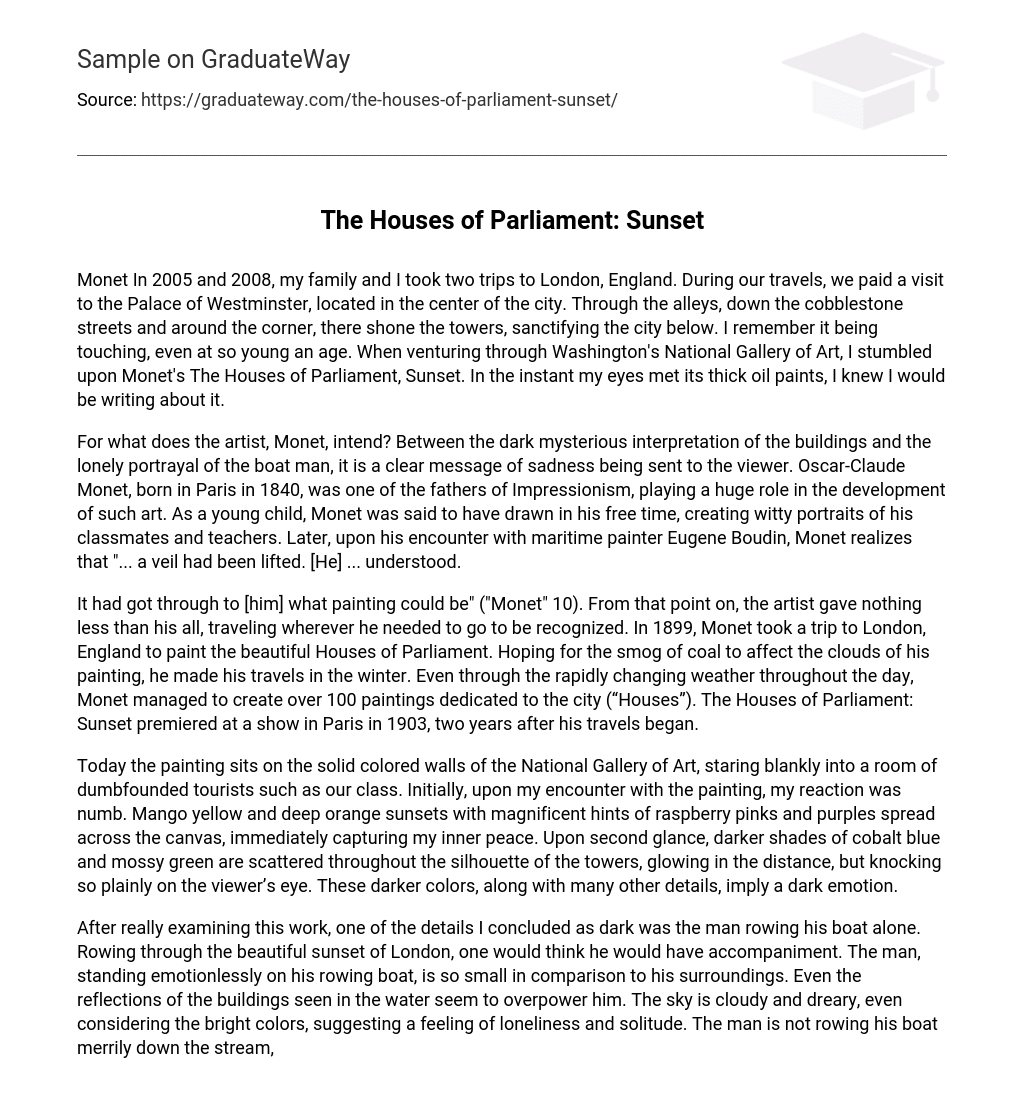Monet In 2005 and 2008, my family and I took two trips to London, England. During our travels, we paid a visit to the Palace of Westminster, located in the center of the city. Through the alleys, down the cobblestone streets and around the corner, there shone the towers, sanctifying the city below. I remember it being touching, even at so young an age. When venturing through Washington’s National Gallery of Art, I stumbled upon Monet’s The Houses of Parliament, Sunset. In the instant my eyes met its thick oil paints, I knew I would be writing about it.
For what does the artist, Monet, intend? Between the dark mysterious interpretation of the buildings and the lonely portrayal of the boat man, it is a clear message of sadness being sent to the viewer. Oscar-Claude Monet, born in Paris in 1840, was one of the fathers of Impressionism, playing a huge role in the development of such art. As a young child, Monet was said to have drawn in his free time, creating witty portraits of his classmates and teachers. Later, upon his encounter with maritime painter Eugene Boudin, Monet realizes that “… a veil had been lifted. [He] … understood.
It had got through to [him] what painting could be” (“Monet” 10). From that point on, the artist gave nothing less than his all, traveling wherever he needed to go to be recognized. In 1899, Monet took a trip to London, England to paint the beautiful Houses of Parliament. Hoping for the smog of coal to affect the clouds of his painting, he made his travels in the winter. Even through the rapidly changing weather throughout the day, Monet managed to create over 100 paintings dedicated to the city (“Houses”). The Houses of Parliament: Sunset premiered at a show in Paris in 1903, two years after his travels began.
Today the painting sits on the solid colored walls of the National Gallery of Art, staring blankly into a room of dumbfounded tourists such as our class. Initially, upon my encounter with the painting, my reaction was numb. Mango yellow and deep orange sunsets with magnificent hints of raspberry pinks and purples spread across the canvas, immediately capturing my inner peace. Upon second glance, darker shades of cobalt blue and mossy green are scattered throughout the silhouette of the towers, glowing in the distance, but knocking so plainly on the viewer’s eye. These darker colors, along with many other details, imply a dark emotion.
After really examining this work, one of the details I concluded as dark was the man rowing his boat alone. Rowing through the beautiful sunset of London, one would think he would have accompaniment. The man, standing emotionlessly on his rowing boat, is so small in comparison to his surroundings. Even the reflections of the buildings seen in the water seem to overpower him. The sky is cloudy and dreary, even considering the bright colors, suggesting a feeling of loneliness and solitude. The man is not rowing his boat merrily down the stream, but sorrowfully around the bend, for perhaps longer than he anticipated.
The water of the River Thames, rather than stretching straight across the page, bends around the buildings. This suggests that the man’s journey is far from over, whether or not he sees it coming. From his position in the work, he cannot yet see around the bend. Planned or unplanned, the man is in for a long trip, travelling with only himself for the duration. To me, this reflects on Monet’s own feelings of loneliness and sadness, travelling to London alone for three years. The bright pinks and oranges of the sky are used to distract the viewer, when in reality it is a very sad piece of work.
The man rowing his boat, along with not knowing the path’s length, may not know where he is going, on the boat or with his life. It winds around the Houses of Parliament and simply fades into the background, with no definite whereabouts of the future of its path. This could be a vague representation of Monet’s works and where he thinks they will lead him. While he is on the path to success, painting over 100 landscapes of the city, there is always the possibility of falling down a waterfall and gaining nothing for them, which is something that is completely unpredictable and out of Monet’s hands.
Solitude, sadness, and abstruseness of the future are three factors represented in the painting, capturing the more sensitive side of Monet. Between the lonely man and the winding path ahead of him, this painting releases Monet’s tension and frustration during his travels, and is a great marker of his journey. Along with the rest of the Houses of Parliament series, the version entitled Sunset will forever glow with passion, staring back at its viewers from around the world.





